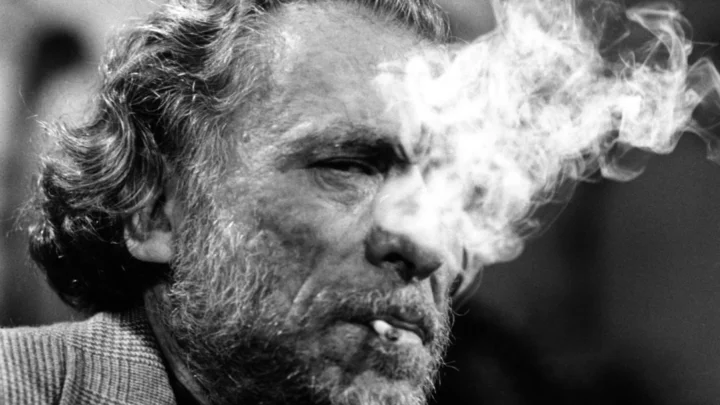The late, great American writer Henry Charles Bukowski, Jr. was once called the “human embodiment of a raised middle finger”—an analogy that Bukowski would probably have welcomed, or possibly even written about himself. His poetry and books were full of bawdy tales of sex, drugs, and violent encounters, and while his impudent style may not be for everyone, many are drawn to the unapologetic frankness with which he writes about the “frayed edge of society,” as Stephen Kessler put it in a piece for the San Francisco Review of Books. Here are a few facts you should know about the author. (Warning: This story discusses child abuse; if you would prefer to avoid that, skip the first fact.)
August 16, 1920, Andernach, Germany | March 9, 1994, San Pedro, California |
1. Charles Bukowski’s father was abusive.
Bukowski referred to his childhood as a horror story with a “capital H.” When asked why in a 1981 interview for Italian TV, Bukowski shared that he had been “beaten with a razor strop three times a week from the age of 6 until 11” by his father. “This was very good literary training for me,” he said, adding that the abuse taught him how to type: “The link is, when you get the sh*t kicked out of you long enough … you have a tendency to say what you really mean. In other words, you have all the pretense beat out of you.”
2. He started drinking at the age of 13.
Though hardly rare among some of our culture’s most famous writers, Bukowski had a lifelong relationship with alcohol that began as a young teen. His friend William “Baldy” Mullinax—fictionalized as Eli LaCrosse in Bukowski’s semiautobiographic novel Ham on Rye—was the first to introduce him to alcohol. “It was magic,” Bukowski later recounted. “Why hadn’t someone told me?” Many years after that first drink, he would say that he didn’t “think [he had] ever written a poem when [he] was completely sober.”
3. The FBI had a file on Bukowski.
In the 1960s, thanks in part to his ongoing “Notes of a Dirty Old Man” column for the Los Angeles underground newspaper Open City, Bukowski managed to catch the eye of the feds. According to Bukowski.net, the FBI and the U.S. Postal Service—his employer at the time—were offended by some of his writings and began to delve into his background. It doesn’t seem like they managed to get much dirt on him, though: Apart from the Open City column, Bukowski’s file consists of his arrest records, bland interviews that agents conducted with his neighbors, and a list of previous addresses and jobs.
4. He didn’t publish his first novel until he was 50.
Although he had been writing and publishing poetry and short stories for years in smaller publications, Bukowski’s first novel wasn’t published until he was 50 years old. Publisher John Martin had offered Bukowski $100 a month (around $965 in today’s money) to come work with him at Black Sparrow Press on the condition that he quit his day job at the post office. Martin mentioned to Bukowski that it was easier for him to market and sell a novel than a collection of poetry, and a month later, Bukowski called him to say he had finished his first novel, Post Office. When Martin asked how it was possible he had written a novel so quickly, Bukowski replied, “Fear can accomplish a lot.”
Post Office, published in 1971, was a semi-fictitious tale about alcoholic, womanizing postal worker Henry Chinaski—Bukowski’s alter ego who had first appeared in the short story Confessions of a Man Insane Enough to Live With Beasts—who would ultimately reappear in five of Bukowski’s novels, a number of his short stories, and the films Barfly and Factotum.
5. Sean Penn offered to star in Bukowski’s semi-autobiographical film Barfly for $1.
Bukowski first wrote the script for the film Barfly, which depicted the life of his alter ego Henry Chinaski, at the request of filmmaker Barbet Schroeder in 1979, but nothing immediately came of it. Schroeder sent the script around to various producers in Hollywood until, finally, Dennis Hopper took an interest in it and showed it to his good friend Sean Penn. Bukowski recounted Penn saying, “I’ll act in it for a dollar. That’ll be my salary.” But the catch was that Penn wanted Hopper to direct, while Bukowski wanted to remain loyal to the man who had invested so much money and time into the project: Schroeder.
Though he insisted on having a sit-down with both of the interested parties, the author eventually stayed with Schroeder, and the role of Chinaski went to Mickey Rourke. Barfly hit theaters in 1987. (Along the way to getting Barfly made, Schroeder also directed a documentary about Bukowski: 1985’s The Charles Bukowski Tapes.)
6. A veterinarian once diagnosed Bukowski with tuberculosis.
As Bukowski got older and more successful, he often rubbed elbows with the Hollywood elite—though he never quite escaped his “wrong side of the tracks” origins. Once, when he was sick, the actor Elliott Gould recommended a fancy Beverly Hills specialist who told Bukowski that he was just “run down” and needed some rest. But he continued to feel ill, so Sean Penn sent him to another Beverly Hills doctor, who told him something similar.
One day, Bukowski took one of his cats (he was an ailurophile, once musing, “The more cats you have, the longer you live”) to the veterinarian to be bandaged up after a fight, and the author mentioned offhandedly to the vet that he himself hadn’t been feeling well for quite a while. After a quick exam, the vet concluded that he had tuberculosis, which was commonly known as a “poor man’s disease,” and something those Beverly Hills doctors had never actually seen before. When Bukowski returned to the (embarrassed) doctor with this information, he was finally put on a proper regimen for TB, and within a year he was OK.
7. His gravestone reads “Don’t Try.”
Bukowski died of leukemia in 1994 at the age of 73 and was buried at Green Hills Memorial Park in Rancho Palos Verdes, California. Although his epitaph may appear to be a depressing write-off of life, it’s actually a line from one of his poems. According to his widow, Linda Bukowski, he was being featured in the Who’s Who in America series—a sort of encyclopedia about prominent living people in the U.S. Primarily composed of self-reported information, one of the questions at the end asked for Bukowski’s “philosophy of life” to which he wrote, “Don’t Try.”
He expanded on his philosophy in a 1963 letter to John William Corrington, explaining that his response to someone asking him “how do you write, create?” was to say “You don’t try. That’s very important: ‘not’ to try, either for Cadillacs, creation or immortality. You wait, and if nothing happens, you wait some more. It’s like a bug high on the wall. You wait for it to come to you. When it gets close enough you reach out, slap out, and kill it. Or if you like its looks, you make a pet out of it.”
Related Tags
BOOKS POETRY MONEY ALCOHOL FACTS LISTS TV WORDS WRITING WORK Home / AUTHORS








